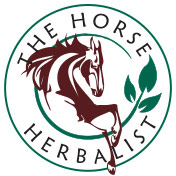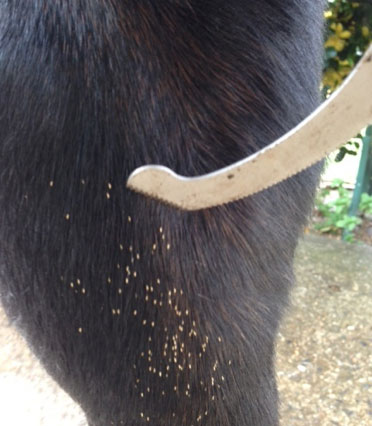
Why Worm?
I recently came across this excellent newsletter from Victoria Ferguson, and asked to share it here as you should all have a read as it contains such important information for you. Victoria has been researching herbal worming programs for many years so it’s exciting that the resulting information is now available to all horse owners. Thankyou to Victoria for giving me permission to share her information here as a guest blog post. – Angela.
Kim Dawson is an expert on equine worms. We are now offering worming programs with faecal counts and advice on treatment. In this newsletter.
TEST BEFORE YOU TREAT – ONLY $7 per horse
ONLY TREAT HORSES WITH AN EGG COUNT
USE CHEMICAL ANTHELMINTICS APPROPRIATELY
USE HERBAL ANTHELMINTICS IN CONJUNCTION WITH NATURAL DIETS
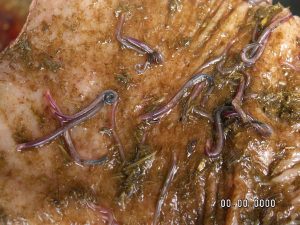
Mature large strongyles in a horse’s gut.
Why do people behave the way they do? Recently we have seen people fighting in supermarkets, hoarding toilet paper and generally behaving like idiots, based on what? Is it pressure from peers, social media or just humans being sheep and not being able to reason things out for themselves?
The same blind faith that someone knows better (generally social media) is what drives horse owners to ignore basic husbandry procedures and conduct parasite programs that are unsuited to the individual horse while promoting the ever-widening problem of resistance in the worm population to the drugs that are currently available to horse owners. And there are no new ones in the pipeline.
A basic knowledge of the parasites that infect horses is a good place to start, if you understand the life cycle and take measures to interrupt that lifecycle you can go a long way to either eliminating or reducing them to levels that are sub clinical and therefore not a problem to the horse. The five main parasites that infect a horse are:
STRONGYLES (large Strongylus spp & small Cyathastome spp)
PINWORMS (Oxyuris equi)
BOTS (Gasterophilus spp)
TAPEWORM (Anoplocephala perfoliarta)
ROUNDWORMS (ASCARIDS) (Parascaris equorum)
These are your main parasites and each has it’s own unique way of dealing with it’s host (the horse). Below is a short outline of the lifecycle of each group:
Small Strongyles These are the small white worms you may see that are expelled after treatment. They have a cycle that is basically 28 days from ingestion of the egg to adults that can produce eggs. They are numerous in number and are prolific egg layers. Their larvae can encyst in the gut wall for many months before they re-emerge and continue their lifecycle. I am of the opinion that the larvae will only do this when the horse is under nutritional distress and the worm is protecting itself from killing the host, a host is no good to a parasite dead, so if they can mitigate their effect, some larvae will go into hibernation until nutritional levels are restored, this is probably why you can see an increase of small red worms in the dung, if horses are treated when there is a flush in the feed, these are the encysted cyathasomes (or small strongyle larvae) that have been killed before they can recommence their lifecycle. If a horse has an even nutritional level and a low parasite burden, encysted cyathasomes may not be too much of a problem.
Large strongyles have basically the same lifecycle from egg to adult but due to their migratory behaviour in the horse can cause a lot more problems. However, the large strongyle that used to cause most of the problems due to it’s progress through the mesenteric artery in the gut, which sometimes lead to arterial clots, is no longer a widespread problem and is only seen occasionally. The other large strongyles are more benign although in large numbers cause problems.
Pinworms, this worm has a long lifecycle of around five months from ingestion of the eggs to sexually mature adults. The female lays her eggs in a sticky substance around the rim of the anus and when the horse rubs it ‘s tail on a post, tree or fence the eggs are removed and stay in the sticky mass until a horse comes and chews the area infecting itself with the pinworm eggs. To check if your horse has pinworms, just lift the tail and see if you can see any yellowish exudates, if there just wash thoroughly with warm soapy water. As they cause horses to rub their tails good idea to give the tail a good wash & condition at the same time.
Bots are actually a fly larvae. The fly lays her eggs on the horse and when the horse either mutually grooms another horse or licks their own legs where the eggs are, they simulate the eggs to hatch and the very small larvae commence their migration from the mouth to the stomach. The entire cycle can take up to three months from eggs being ingested to the adult leaving the stomach via the alimentary canal to be deposited in the manure where it will burrow into the ground to complete it’s lifecycle. An adult fly will emerge, depending on the conditions from three to ten weeks, where the cycle begins again. Prevent ingestion by removing bot eggs with a bot knife regularly. 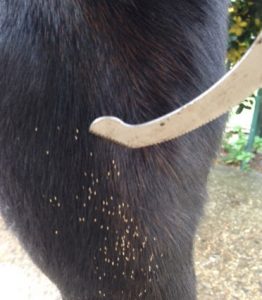
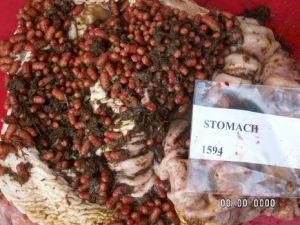 Bot larvae in the stomach of a horse.
Bot larvae in the stomach of a horse.
Tapeworms, not like the ones you might see in your cat or dog. The horse tapeworm is relatively small, varying in size from three to eight centimetres and resembles an Egyptian sarcophagus . They can cause colic in horses as their favourite location in the horses gut is at the junction between the caecum and the large intestine, if there is enough numbers they can cause a blockage. However, as with many parasites, tapeworms are becoming less of a problem due to the use of macrocyclic lactone (or ML) drenches, not only do these drenches kill parasites but they can decimate the soil fauna such as dung beetles. The tapeworm requires the help of an intermediate host, the orbatid mite, if this mite is not present then there is no infection, even if a tapeworm positive horse comes to your property, if the mite is not present no other horses will be infected and the tapeworm in the positive horse will eventually all be expelled and the horse becomes tapeworm free. If a tapeworm positive horse releases infective segments in their dung and an orbatid mite comes along and does what feeding mites do, ingests an egg, this egg then develops to larval stage in the mite about twelve to fifteen weeks. A horse then grazing eats the infected mite and the tapeworm continue on it’s lifecycle for about six to ten weeks where it can start to shed infected segments.
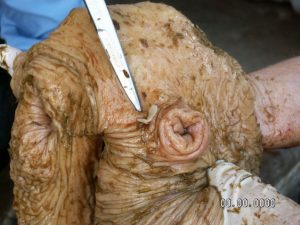
Tapeworm near ileo-cecal valve.
Roundworms, mainly found in foals but older horses can also be infected if the level of contamination in the paddock is high enough. The egg is highly resistant to everything and can remain in the ground not for days but months or years, so once a high level of contamination is present it can be a ongoing problem to get rid of it. The cycle from egg to mature adult can take up to fifty four days and the main problem caused by ascarids is the migratory pattern through the lungs. The adult parasite ends up in the small intestine and this is where it can cause trouble for foals as the intestine is fragile and can rupture easily if large numbers are present, adult horses have more structural integrity in their gut lining and not as likely to suffer the same fate, but large numbers of adult worms are also stealing nutrients required by the horse.
MYTH BUSTER
Just because you can’t see any worms in the manure it doesn’t mean the horse doesn’t have them.
THE RESISTANCE PROBLEM
So what do we do with this information? You would think that it would be an easy answer but you would be wrong. Various groups have been trying to get people to think about their parasite programs for years and years, with varying degrees of success. Once again social media, uniformed horse forums and owners who just think it’s easier to drench, have perpetuated myths and just bad advice on how to handle a worm problem in horses. So not only are people being misled by misinformed opinions but they continue to believe the “information” being put out by the veterinary companies producing anthelmintic wormers. The worm every 6 – 8 weeks or perish propaganda is still going strong in the horse community without any valid reason in many cases for such high levels of anthelmintic treatments. Present treatments have their place but must be used in conjunction with more targeted responses or the horse industry will end up like the sheep and cattle industries, rampant resistance to the anthelmintic in the parasites.
There are several ways that a correct program can be instituted that combines knowledge of the parasite problem, correct interventions or treatments (anthelmintic and herbal) that can provide owners with confidence.
- TEST BEFORE YOU TREAT – a simple faecal egg count can be conducted on your horses to ascertain the actual problem. There are many laboratories conducting these tests and although the prices range it is a good diagnostic tool to determine if your horse needs to be treated. These tests can pick up strongyle and ascarid eggs easily and also tapeworm and pinworm eggs if the infection rate is high enough (some labs are better than others at detecting tape and pinworm eggs). If you have only a few horses per paddock it is an easy matter to test all the horses and then only strategically treat the ones with a treatable egg count. If you have a heavy stocking rate, you can use the horses as the test subject to see how wormy your paddock is, doing this you would only test a percentage of the horses in the paddock and treat accordingly. If the animals have a high count treat the lot and realise that that paddock is wormy and either spell or rotate into clean paddocks.
Many horses have a natural resistance to worm burdens and testing shows these individuals usually have nil to very low worm counts.
- Refugia, this is the concept of leaving a certain amount of larvae to be retained by the animal. It works on the idea of a population curve, if you kill off all susceptible worms it only leaves the resistant ones and before you know none of the commercial products work and you may not be able to graze horses on those paddocks for many years or you have dead horses.
- Rotation of anthelmintics, not changing brands but changing the anthelmintic family, from ML, such as Equimax to the benzimadoles, such as Strategy –T. This rotation can be used to slow down any resistance but anecdotal information tells of resistance in most families becoming a huge problem.
- Use of natural feeding – the VF Natural Diet provides a good basis for helping to keep worm
burdens low by promoting a healthy gut.Some of the feed items appear to inhibit worms – French white millet, boiled linseeds and fresh raw Garlic.The VF Natural Diet provides all the essential nutrients in the form of raw, natural feeds and herbs as well as providing preventive nutrition. This promotes disease resistance, prevents illness and disease and strengthens the immune system
- Management – of your horse and pasture can play a huge role in delaying or saving you from a problem with full blown resistance in the worm population in your horse/s. Such as fencing off manure piles to prevent horses grazing around that area, harrowing paddocks to break up dung piles and expose the eggs to either hot sun or freezing air to hopefully desiccate them so they die, provide hay off the ground so that the horses are not “hoovering” the ground. Ideally collect manure regularly from paddocks and yards and introduce dung beetles. Remove bot eggs from horses’ legs with a bot knife regularly thus preventing from from getting into the stomach in the first place. Dispose of eggs in the rubbish. The idea is to break the cycle of the worms and to provide owners with an outcome they have confidence in.
It can’t be stressed enough that testing before you treat in the long run will provide the horse community longer access to commercial treatments. Treating horses that don’t have an egg count because it’s due is as stupid as hoarding toilet paper because someone on social media said that we were all going to run out. If people actually think about the parasite and how they can protect their horses from over use of chemicals not to mention what these chemicals do to the soil fauna like dung beetles, both the horse and the owner will be better off.
RECOMMENDED PROGRAM
Our recommended program is to faecal test every 3 months, preferably at the beginning of each season. This enables you to tailor your worming program to each individual horse. Many horses never have worms at all, so don’t need to be given a worming product. Horses with consistently very low counts don’t need to be given a worming product either. Horses with medium to high counts need to be treated with an appropriate product to reduce the counts to very low or nil.
FAECAL TESTING & PRODUCT ADVICE SERVICE
Kim Dawson is offering my clients inexpensive faecal testing at only $7 per horse – cheaper than a worm paste – as an incentive to join the program.
It’s easy to participate – if you are an existing client email me and I will email you the chart to complete & return with faecal samples to Kim. You will then be provided with a report by email, with copy to me, and product recommendation for horses that need treatment, both veterinary chemical products and VF herbal products will be advised, including dosage schedules, so you can make a choice.
If you are not an existing client – get your diet consultation at this link:
https://www.victoriaferguson.com.au/natural-horse-feed1/
ABOUT KIM DAWSON
Kim Dawson graduated from Hawkesbury Agricultural College with an Advanced Diploma in Grazing Animal Husbandry & has worked in endo & ecto parasitology in domestic livestock for over 33 years. In that time Kim was heavily involved in the research and development of many of the commercial parasiticides currently available. Kim has worked extensively in the equine field in both a laboratory setting and in the field & has designed, conducted and reported on these studies as well as authored and co-authored many articles. Kim has advised Victoria Ferguson in her quest to find efficacious herbal wormers by conducting a number of in vitro and field worm trials.
Post a Comment
You must be logged in to post a comment.
